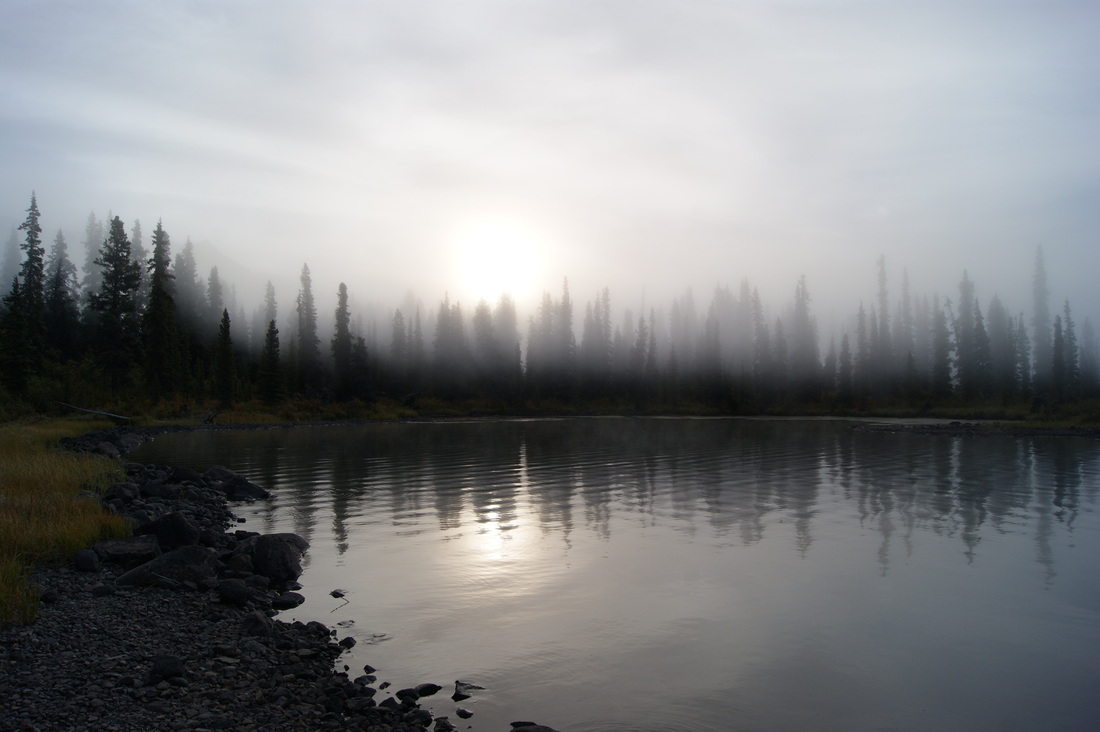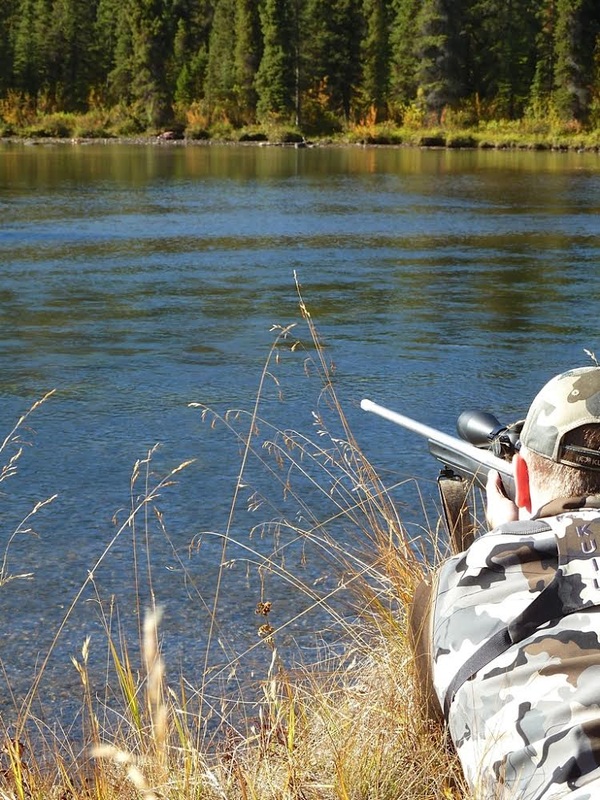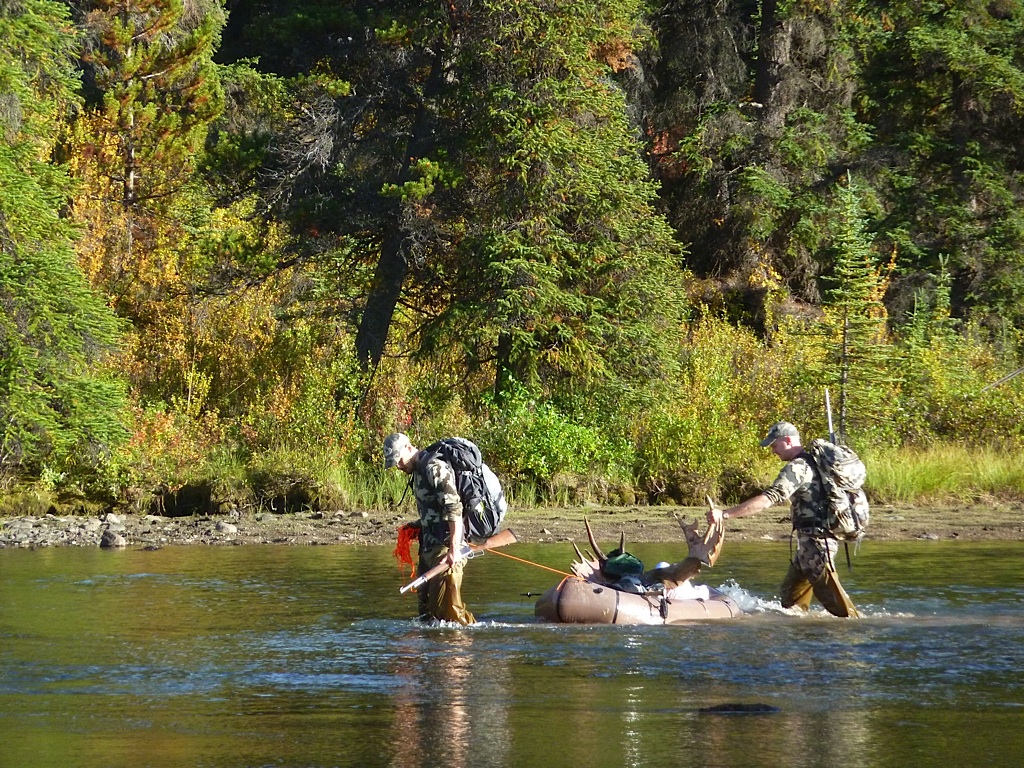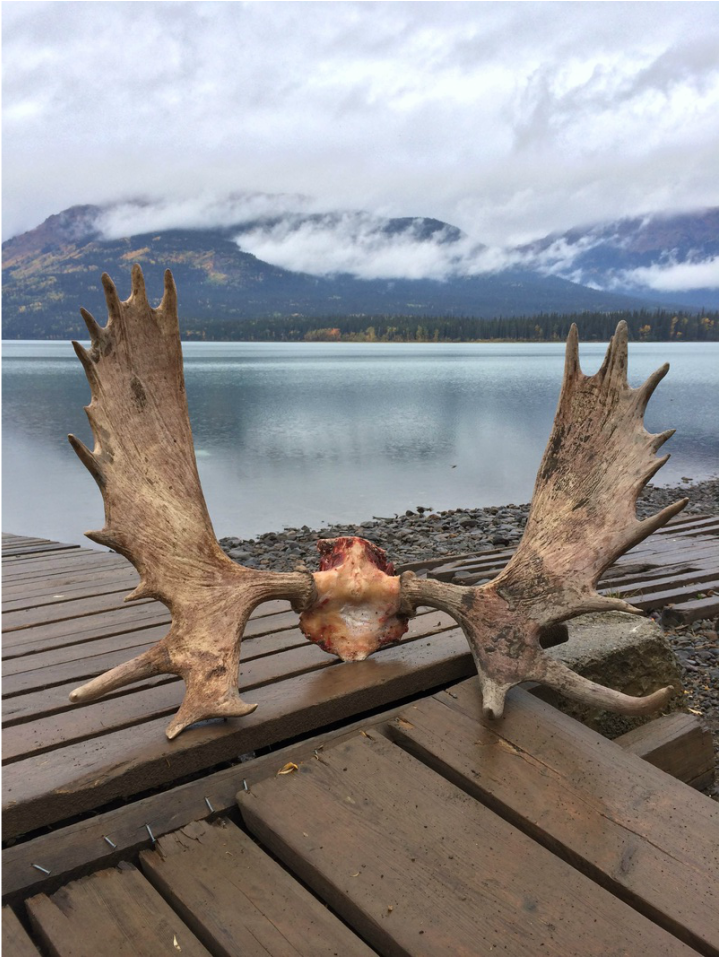Note: Colin is an Assistant Editor of The Journal of Mountain Hunting
What struck me most the first morning of our Spatsizi fly-in hunt this September was the feeling of solitude. That and it was the most beautiful place I have been on earth. I had said good-luck to my two hunting partners, Adam and Alan, a few minutes earlier; they set off together to scout for goats while keeping an eye out for moose. The plan was to hunt the morning and meet back up at camp around noon to talk about what we had seen, and to come up with a hunt plan for the coming days.
I checked my watch; it was 6:30am. There was just enough light to see the edges of the water while I stood on the rocky shore and inflated the Alpacka Raft. A beaver swam nearby, keeping an eye on me and slapping his tail on the surface of the water every so often.
I put my pack in the raft, slung my rifle over my back, and pushed off from shore. This was it, the start of my first ever moose hunt. I’d been on numerous elk, bear, mule and blacktail deer hunts but what I was about to learn in the next three hours was incredible – seasoned hunters will hear about my hunt and no doubt crack a wry smile and give a slight nod. Those who, like me, have never hunted moose before will hopefully glean a tip or two from this story. I put some thoughts together below on what went well, and what I would do differently.
Spatsizi Day Break
As I paddled along the shore line I had to remind myself to stay focussed – it was hard with the day breaking and the sheer ruggedness of the mountains and landscape around me. Spatsizi Plateau Wilderness Provincial Park in British Columbia was a years-long dream of ours to hunt, and I was soaking it all in as I drifted along. I stayed close to shore and within 20 minutes of paddling spotted some large, deep moose tracks in the sand. Beaching the raft, I put on my pack, checked the wind (steadily in my face), and slowly crept downstream.
From the hunters I’d talked to before my trip, and the hours of hunting videos I’d watched on WildTV and Youtube, I knew that it was important to be patient, move slowly, and stop and call frequently. The hard part was waiting 15-20 minutes after calling, to see – or more realistically hear – if anything was moving.
Having only really let rip a cow call a few times in the confines of my own home, it was time to see what I could do. After a couple of set ups, I still wasn’t at all sure whether the sounds I was mustering would work. The moose tracks I was following went up a game trail and into a very swampy looking area. I decided to stick to the shoreline.
Later, back at camp, Alan and Adam busted a gut telling me how they could hear my first few attempts as they moved away from camp and wondering if I was trying to imitate free-range cattle. Hey, I was out there, doing my best, and learning as I went.
After a couple hours of moving down the creek I stopped for a snack and some water. Again, I felt distracted from the hunt, and spent some time simply looking around at the mountains and glassing goats with my binos. It was a glorious day.
Taking It All In
It was just after 9:00am, and I was on the move again. I got to a bend in the creek with a small bay on the opposite side, and let out a long, mournful (and likely pitiful) cow call. Immediately, I heard the distinct “Ooo-AHH” of a bull moose. I seriously couldn’t believe it. I was standing on the edge of an elevated bank, with the creek running six feet below me. The bull was across the creek, back in the deep timber behind the small bay.
Quickly I threw off my pack and tried to come up with a game plan. At first, I placed my pack on the edge of the bank, but when I laid down to get ready for a shot it just didn’t feel right. I pushed the pack to the side, and parted the knee-high grasses so I could lay prone and prop myself up on my elbows. By the time I got settled, I realized the moose had gone quiet and I should call again.
I let out another cow call, and just as I finished the bull grunted again. Louder this time. He followed up the grunt by destroying some trees and branches around him. There was certainly no mistaking his location. He was now about 200 yards away from me, and at least 50 yards from anywhere that I might catch a glimpse of him. And that’s as far as he felt like going.
I remembered some advice on dealing with a bull that was hung up, which was to make him think another bull was with the cow. Feeling like I had nothing to lose, I gave my best two bull grunts, and again he responded immediately by grunting back. Then he gave a long “chortle”, a sound I had never heard before and didn’t even know a moose could make. I could hear him bashing through the trees and I got settled behind the rifle, looking through the scope and then out at the bay, not entirely sure where he would show up.
Re-Creating The Shot A Day Later
I saw the first flash of a paddle when he moved through a gap in the trees, 130 yards from me. With a Limited Entry moose tag in my pocket (any bull, no point restriction) I had decided much earlier – before the trip began in fact – that I would take the first good shot I had at any legal moose. The sight of the large paddle startled me, I had not expected to see a moose this big, let alone be calling one in on the first morning of my first moose hunt. Talk about beginner’s luck! The moose was moving from left to right at a fair clip.
Knowing the direction the moose was moving in, I took aim at the second clearing where I figured I would get a broadside look at him. He was coming in hard and when he burst into the clearing I could see those wild eyes I had seen in rutting bulls on video. I settled the crosshairs just behind his front shoulder and squeezed the trigger. The 130 grain Trophy Copper bullet from my 270wsm landed hard. The bull reared up on his hind legs and kicked himself forward and I chambered another round. I again put the scope ahead of where he was going and pulled the trigger as he walked into my crosshairs. The second bullet was bang on as well, right behind the shoulder, but he did not go down.
At this point I remembered another piece of advice – this one from my hunting partner Alan – which was to keep shooting until the animal goes down. In the deep bush that characterizes much of British Columbia’s wilderness, it’s wise to do everything you can to prevent a long and possibly unsuccessful or dangerous tracking excursion.
I shot a third time as the moose turned facing me – the bullet entered the centre of his chest and stopped just under the hide on the back of his neck.
Recovered Trophy Copper Bullet Back Home – 130 Grains Expanded Perfectly
He was still standing, and I still had one more round, so I put it in the same spot as the third shot. At this, the bull went down.
It was just before 9:30am on our first full day in Spatsizi, and my moose hunt was over. I felt elated and a bit in shock at the same time. I remember thinking “did that just happen?!” over and over in my mind as I unclipped my Crocs from my pack, took off my boots and socks, and prepared to cross the creek.
When I got to the other side I sat for a couple of minutes looking at the bull, cut my tag, and moved around to the front of him to lift his head. I could move him a bit, but this was certainly no mule deer-sized animal where you could prop up the head or body for some field shots. I sank in the muddy bank as I lifted his antlers. What an incredible animal.
I then crossed back to the side of the creek I had hunted down, went to retrieve the raft, and made a quick stop back at camp to leave Alan and Adam a note. This is what the note said: “Boys: Please come help with my moose if you get back today. Follow the shoreline, it’s a 25 minute walk. Bring Wiggies – one easy crossing. Keep eyes open very fresh grizz, wolf, moose tracks. Did I hear a shot at 10am? Colin.”
As He Lay
Stainless Synthetic Rifle Standing Up To The Elements After Falling In The Mud
As I arrived back at the moose, Alan popped out of the woods. It turns out Alan and Adam weren’t too far away when they heard my shots (and no, that wasn’t a shot I heard at 10am). At the first shot they were excited, they told me, then they heard the second, and the third. They willed there to be another shot, for fear that I was trying to get their attention with the 3-shot “something’s wrong” signal. We were in serious grizz country afterall. And then came the fourth shot and they celebrated. Adam arrived a short while later, and we got to work quartering, then deboning. It was a long day – we didn’t make it back to camp until dark, Adam and I hauling the meat plus the head and antlers, some 500lbs all together, up the creek in the Alpacka Raft. We got the meat hung in the Caribou Game Bags not far from camp, and could finally relax, eat, and celebrate.
500lbs Of Moose Is Easier Towed Than Strapped To Your Back
My Moose Back At The Dock At Tatogga Lake
What Went Right
I’ll start on a positive note and make a few comments about what I thought went right:
- Number 1, hunting with guys you trust and whose company you enjoy is really important. It also helps if they are planners, which Alan and Adam certainly are. In hindsight the hours and hours we spent deciding where to hunt this year were a small investment that paid off big time. We had an early deadline for LEH tags, and luckily we did alright in the draw. It can’t be stressed enough that doing your homework increases your chances of hunting an area where you’re going to see some game and few (if any) other hunters.
- We had great gear. From the Alpacka Raft, to the Caribou Game Bags, to our optics, knives, packs, clothes, etc., we were ready for this hunt. When you fly in you need to have everything with you to take care of these large animals. Stainless synthetic rifles with all-copper bullets are also high on my list. My rifle has taken a real beating in the last three years, and it has maintained its accuracy and functionality no matter what I’ve thrown at it. I have grown to trust that gun in all conditions. You absolutely must invest in the best gear you can afford to be fully prepared for a mountain hunt.
- Experience with moose – ok, no not me obviously, but Alan has shot his share of moose and Adam has field dressed and de-boned many an animal, so between him and Adam the quartering and hanging went as well as you can expect when you drop a moose in a muddy area. To be honest, I have no idea what I would have done if their scouting mission that morning turned into a one- or two-day spike out. More below on this point.
- Perhaps it was being in the middle of nowhere with no other hunters around (or so I thought), but don’t be shy about sounding ridiculous if you’re not an experienced caller. Of course, do your best and get some pointers from other hunters or videos, but the point is, a rutting bull will respond to a beginner.
- Get your meat hung right away. Even though my moose went down on morning one of a 9-day trip, we didn’t lose any meat at all to rot or spoilage. Deboning is vital to getting the meat cooled quickly. Bring a tarp to keep the rain off your game bags, as well as spikes to drive into trees to set up your pole.
- Pick the animal you want most and go for it. This doesn’t apply to all hunts, but in areas like Spatsizi you can go in with 3-5 tags; not all species live in the same areas (and often they are in vastly different regions), so to avoid wasted time during the hunt prioritize what is most important to you and talk it through with your hunting partners. This will help each guy draw up his day-to-day game plan.
- If beginner’s luck shines on you, take it!!
Things I learned / What I would do differently
- Not so much for the moose part of the Spatsizi hunt, but for the ensuing 8 days, everyone says it but I’ll say it again with personal experience: you need to be in the best shape possible for these hunts. For a variety of reasons, none of which really pass muster, I went into this hunt a fair ways away from my optimal physical shape. It is not fair to yourself or your fellow hunters, and I learned firsthand how important this is in mountain hunting. You need to be ready to get up and down mountains, carrying heavy loads, if only so you don’t slow down your hunting partners or limit the range of your hunt. So, for every hour you put into trip planning, or dreaming about big or elusive mountain animals, you should be putting in the same time (or more) preparing your body. There are few things as important as this tip, and I’m motivated in a serious way to be ready for next season in the mountains.
- I have not spent nearly enough time shooting from different positions, including prone. You never know what terrain you will end up in when it’s time to get ready for a shot, so as much as possible practice all sorts of positions before the season starts. If you can, do this is the field and not at a range.
- I would be more on the fence on this point if we didn’t have a grizzly encounter, but when in an area like Spatsizi you might want something heftier than a 270wsm. It’s a great sheep/goat/caribou/moose round, and my moose didn’t go more than 30 feet from where it was first shot, but the bush can be thick and we know with certainty that it is thick with grizzlies. Also, while my first shot hit vitals and was a kill-shot, I have a hunch a bigger bullet would have knocked him down sooner (for example if all I got was one shot on the bull before he tore off into the timber). For those reasons I’m looking at a larger calibre for next season. Whatever I end up with, I’ll stick to the copper bullets.
- Do not hunt solo if there is any chance that your hunting partners might be gone for more than the day. There is simply too much work to do taking care of a moose to go it alone, unless you are planning for that. As well, I can’t say that I would want to be arms deep in a moose, solo, in country that holds this many grizzlies (there are four in this shot with a fifth off to the left taking a mud bath).









